Fixing the toilet to the floor: an overview of possible methods and step-by-step instructions
Typically, fixing the toilet to the floor is carried out at the stage of housing construction and is carried out by professionals. However, during operation, sometimes there is a need to replace equipment, and here the owners sometimes end up in a dead end.
Someone immediately turns to the company that provides the appropriate services, but some home masters decide to save money and make a rearrangement on their own. There are no big difficulties in this, and installation methods are quite accessible even for people who do not have a lot of repair work experience.
In this article, we will talk about different ways of fixing the toilet to the floor, as well as what tools and materials will be needed for this.
The content of the article:
Methods for fixing toilets to the floor
You can attach a toilet to the floor in several different ways.
The most popular are:
- landing on the installation kit (dowels);
- the use of various adhesive compositions;
- installation on cement mortar;
- fixation on taffeta;
- side mount.
The choice, first of all, depends on the quality of the floor in the toilet or bathroom and on the material of its topcoat, since the same method of fastening is not relevant for all surfaces. Features and nuances of different installation options depend on the design and type of discharge into the sewer.
Complete with toilets of almost all modifications is a standard installation kit (dowel screw). It is suitable for installation of equipment, but provides for the compact to land on an absolutely flat surface that does not have errors and incline.
Plumbing, attached to the floor in this way, has good structural stability and does not swing even during intensive use. However, the method is not suitable for all models and is usually applied to toilets of small size and light weight.
Mount toilet to tile cement is considered one of the most durable options for connecting the base of the equipment with the floor. The experts reproach this method only with the impossibility of quickly dismantling the product in case of urgent need.
That is why only those compacts that are supposed to operate for a long time without replacement are "planted" on cement.
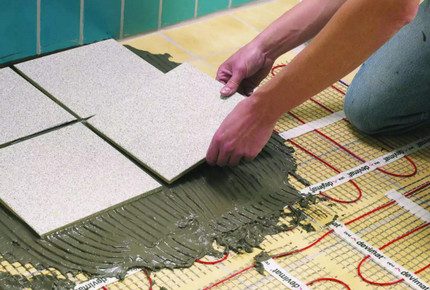
The hidden method of fastening is not much different from the open, it only requires a lot of effort and labor. But all this completely pays for itself, because externally the design looks more attractive, neat and aesthetically pleasing, and the connecting elements are disguised from the eyes and do not spoil the interior design.
Preparatory activities before installation
Regardless of how it is decided to fix the toilet to the bathroom floor, they always begin work with collecting the drain tank. The process directly depends on the compact model and is usually described in detail in the instructions that came with the equipment.
At the second stage, water supply and discharge units are prepared. If the connection is made to an old, cast-iron riser, it is first cleaned and dried well so that later there are no problems with the tightness of the corrugation.
Having completed these two steps, they proceed to the third and ensure the availability of all connecting elements, materials and a suitable tool for the implementation of the necessary installation and plumbing activities.
Tools and materials for work
In the process of work, depending on the type of floor in the bathroom, use tools such as:
- drill with drill bits of different diameters (when it is planned to drill concrete or cement);
- hand drill and drill for wood or ceramics;
- screwdriver set, hammer, pliers, wrenches;
- tape measure, marker;
- sandpaper of large and small section;
- spatulas (if it is intended to fix the equipment on glue, epoxy resin or cement);
- scissors, construction knife.
In addition to the above items, you will definitely need:
- dowels, screws with gaskets under the head;
- connecting corrugation;
- flexible hose for connecting to cold water equipment;
- cement;
- adhesive composition (silicone sealant, epoxy resin, liquid nails);
- a piece of thin rubber for a sealing gasket under the base;
- a board with a thickness of 28-32 millimeters, if it is necessary to raise the plumbing above the floor or fixing is carried out to a wooden coating.
Having all this at hand, there is no difficulty in coping with the task.
How to put a toilet on the dowels?
Fixing plumbing to the floor on the dowels is considered the most affordable and practical option, requiring the least amount of time to carry out work. However, for proper installation, it is necessary that the floor surface in the bathroom is perfectly flat and smooth.
Even the most insignificant differences in height negatively affect the quality of flushing and make it difficult to fully use the plumbing for its intended purpose.
If the surface of the floor is tiled, you will have to drill holes in the tile for installation. This event requires accuracy and some skill.
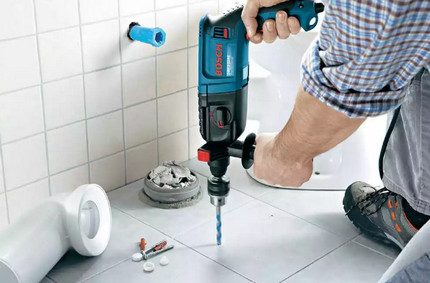
When working, you must not rush and put too much pressure on the tool, otherwise cracks may appear on the tile and the fragment will have to be removed.
In addition, the dowel mount is designed primarily for compact, lightweight toilets of small dimensions.For heavy, massive models, this option is considered not the most suitable, since it does not provide a reliable and stable position of the plumbing fixture.
The following photo selection will demonstrate the steps of installing and securing the toilet using dowels:
These steps are the preparatory stage, having successfully dealt with them, you can begin the main work:
Detailed fastener instructions
To properly fix the toilet on the dowels to the floor, first markup and mark the future location, outlining the bottom of the compact with a marker or pencil along the contour.
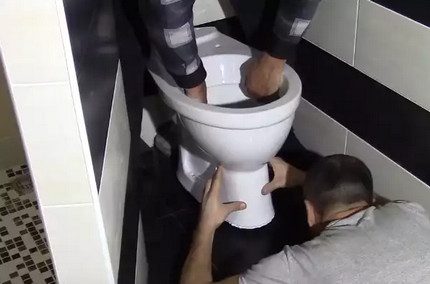
Then mark the location of the centers of the holes for dowels and carefully drill them with a drill. Drills are used depending on the flooring. For tiles, a ceramic drill is used, and for parquet or laminate flooring, a drill for wood is used. When a hole in the tile or wood is made, the drill is changed to a construction punch.
A drill is placed on the tool for working on concrete. So that the fastener clearly sits in size and does not hang out, a mark is made on the drill with electrical tape and a hole is drilled that perfectly matches the length of the part.
Then insert the dowels and the toilet itself, and then combine the holes in the base of the plumbing fixture with those drilled in the floor.

The pipe coming out from under the toilet bowl using the corrugation is connected to the sewer. Through the holes available in the lower supporting part of the toilet bowl, the connecting bolts are inserted into the dowels together with plastic gaskets or rubber washers.
In the process, they act very carefully so as not to overtighten the screws and not damage the integrity of the toilet.
They clearly screw the plumbing to the floor and close the fastening caps with decorative overlays made of polymer. The connection of the corrugation to the sewer is treated with a sealant or some other means with similar parameters.
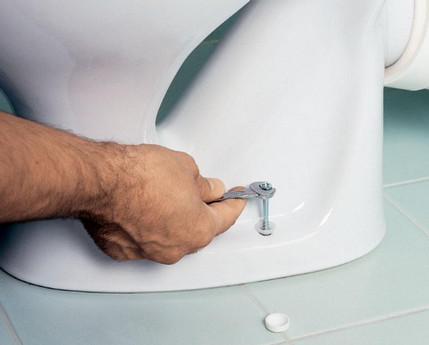
At the finish, carefully examine the area of contact between the base of the equipment and the floor and perform cosmetic masking of cracks, if any. Then the whole structure will not only hold firmly, but also look aesthetically pleasing in the interior.
There is also an article on our site with step-by-step instructions on how to fix the toilet on the tile, we recommend reading it.
How to make a side mount?
The side mount option is similar to the dowel method. The only difference is that all the connecting elements are inside the foot of the base of the toilet. Before installation, they also make markings, and only then they put the plumbing module on top.
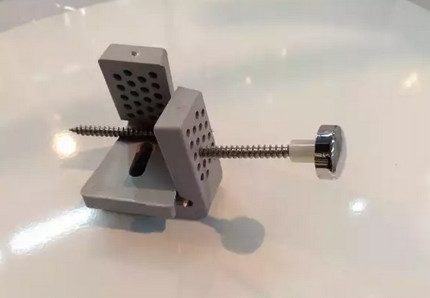
The work is painstaking and requires additional time. But in the end, the design looks much more aesthetic and attractive.
Mounting with adhesive
Putting a compact on glue is a very simple way of fixing equipment to the floor, but it takes a considerable amount of time to implement an event. The adhesive mixture should solidify qualitatively, and this usually takes 12 hours or more.
Fixing the toilet with an adhesive is extremely simple:
If you start using the plumbing module earlier, the base will quickly become loose and will not withstand even six months of full operation.
This installation method is absolutely safe. In the process, there is completely no risk of damaging the plumbing itself or tile. After installation, the bathroom does not leave dust and dirt, so large-scale subsequent cleaning of the room is not needed.

The contractor does not need to have any professional skills or extensive experience in carrying out repair activities. Everything is limited by the ability to use a glue gun and the tendency to accurately and pedantly perform tasks.
Initially, they mark up and determine the future placement of the compact. It should be located comfortably for use, be accessible to sewer communications and connect to the water tank without any problems. When all conditions are met, the base of the sole is outlined with a marker or pencil.
Before fixing the toilet bowl to the floor with an adhesive mixture, both surfaces to be joined are thoroughly cleaned, while simultaneously cleaning around possible debris and dust.
If the installation is carried out on a slippery, smooth tile, then to start the tile is treated with a drill with a nozzle in the form of a metal brush. It will partially remove the varnish from above and make the tile a little rougher, which will significantly improve its future adhesion to the glue.

Then the surface is treated with a rag soaked in a solvent, acetone or ammonia.
After this procedure, no fat will remain on the surface, and its adhesive qualities will become an order of magnitude higher. Then the place is wiped dry with microfiber.

Glue paste or silicone sealant, previously purchased in a hardware store, is carefully applied to the base of the toilet bowl.
Then the plumbing is transferred to the place of future deployment and installed in the place previously marked with a marker. The area around the bottom of the toilet is sprayed from the spray bottle with soapy water.
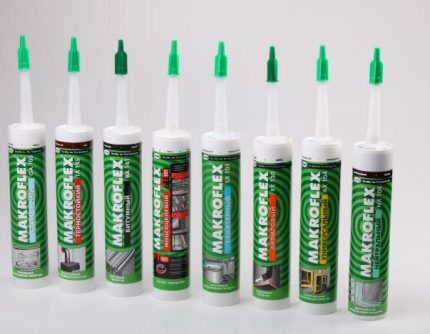
Such processing is required so that in the process of subsequent finishing correction, excess sealant is easily cut off and does not stick to the tiled floor.
The silicone spatula is moistened with soapy water and the adhesive that protrudes from the bottom of the toilet bowl is removed. Do this immediately after installation, when the mass has not yet had time to harden.
After all the above manipulations, the plumbing is left for 12-24 hours, so that the composition (sealant, silicone glue, epoxy or other) is stable and completely dried. During this period, they do not use the toilet and do not even touch it. Compliance with this point is extremely important and ensures the subsequent reliable and comfortable operation.
After a day, when the glue tightly clings to the floor, the toilet is connected to sewer communications, let in cold water and mount the seat with a lid.
Cement toilet
Mounting a plumbing module on cement is a more obsolete method of fixing, which is now chosen much less often. In terms of the main points, it resembles the above installation option for glue, but instead of modern mixtures and sealants, self-prepared cement mortar is used here.
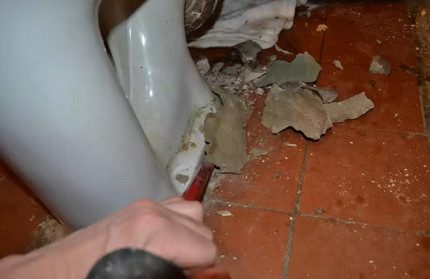
To make the bathroom look more attractive in the future, make a small recess in the place determined for installation, carefully clean it from debris and dust, fill it with prepared solution to the edges, and place the toilet bowl on top, soaking the edges of the sole with water.
Excess cement is carefully removed with a spatula and left to harden for 24 hours. At the end of time, they are connected to the drain sewer and water is supplied to fill the tank.
How to fix the toilet on taffeta?
Most often, this method is used for mounting compacts on a wooden floor. Taffeta - a laying made of high-strength wood with a thickness of 28 to 32 millimeters - is cut to the size of the support column of the plumbing device.
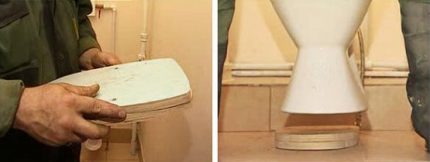
From the bottom, anchors are attached to the part or ordinary nails are driven in a checkerboard pattern so that they protrude 2.5-3 centimeters from the base. A recess previously made in the floor is poured with a cement mortar. Top with anchors down put taffeta. As a result, it should be flush with the general floor surface.
After 12-15 hours, when the solution dries and hardens, the toilet bowl is screwed to the resulting wooden base. Rubber or silicone gaskets are always placed under the heads so that the structure holds more securely and does not lose stability during operation.
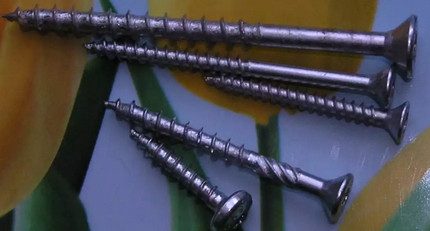
According to plumbers, a wooden part may well be replaced by a rubber one. It is cut out from high-density material (average thickness 5-15 mm). So that the edges of the rubber do not stick out, it is cut out slightly less than the size of the base base of the bottom of the toilet bowl.
The photo gallery will familiarize you with the stages of installing a toilet on a taffeta:
The most common mistakes in work
When conducting plumbing work, it is necessary to observe clarity and sequence of actions. This will ensure in the future the absence of leaks, unpleasant odors and other negative aspects in the bathroom.
When fastening a compact toilet to the floor, it is very important to carefully level the surface on which the plumbing fixture is placed.
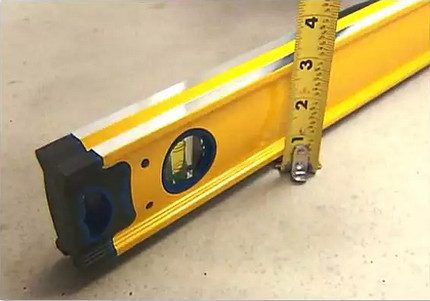
Ignoring this item happens quite often and leads to a violation of the integrity of the system, the appearance of leaks and subsequent failure of the equipment.
Another crucial point is the absolute tightness of all butt joints and the rigid installation of fasteners. It is especially important to pay attention to the connection area. corrugations to the toilet outlet.
In the future, sewage liquid may be released through the poorly finished edge, which will cause the appearance of sharp, unpleasant odors in the bathroom.
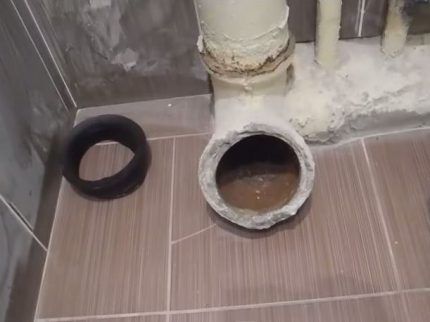
To guarantee, it is possible to apply sealant not only to the inner surface of the pipe, but also to make an additional outer layer, thinner on top and thickened at the bottom. Neither liquids nor odors penetrate such a barrier.
When attaching the toilet to the floor on the dowels, you need to act carefully and without rush. If you overdo it and fasten the plumbing too tightly, it can crack during operation.
Very weak fasteners are also not an option, since the compact will begin to swing, and water will ooze from under the base. It is advisable to observe the “golden mean” here and create an optimally reliable, stable mount.
A careful attitude to the process and taking into account all of the above points will help to attach the toilet to the floor accurately and clearly, avoiding in the future the need to redo everything or make adjustments to the work.
Conclusions and useful video on the topic
The video tells in detail how to quickly, easily and without using expensive electric tools securely and firmly fix the toilet on the tiled floor:
The video describes the method of mounting the toilet on silicone sealant and describes some interesting nuances of installing plumbing equipment on the "warm floor" system:
Features of fixing to the floor and installing a toilet with a lower connection - useful tips, tricks and tips from an experienced master:
Decide on toilet mounting method only the owner of the real estate in which the installation or replacement of equipment is carried out can access the floor of the bathroom. You will have to choose based on the finish coating of the bathroom floor, the model of the toilet itself and the overall design of the room.
Attentiveness, accuracy, scrupulousness and the above helpful tips will help to do everything right, quickly and no worse than what would happen to professionals.
Have questions about the topic of the article? Or maybe there is experience in self-fixing the toilet to the floor, and you can give practical advice to the novice home master? Please leave your comments, share experiences, ask questions in the block located under the article.

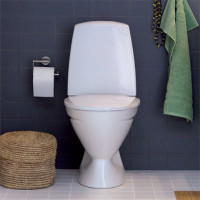 How to fix the toilet to the floor: an overview of the technical details and the best installation methods
How to fix the toilet to the floor: an overview of the technical details and the best installation methods 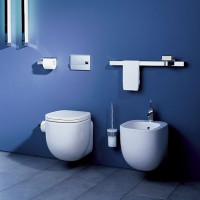 Installation of a toilet bowl installation: detailed installation instructions for a wall mounted toilet bowl
Installation of a toilet bowl installation: detailed installation instructions for a wall mounted toilet bowl 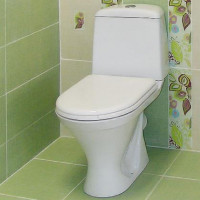 How to install a toilet on a tile: an overview of the best ways and technical nuances
How to install a toilet on a tile: an overview of the best ways and technical nuances 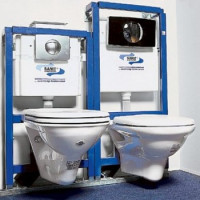 Securing the toilet for installation: step-by-step installation instruction
Securing the toilet for installation: step-by-step installation instruction 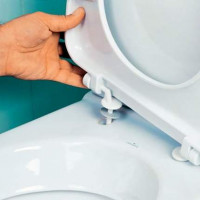 Securing the toilet lid: how to remove the old and install a new seat on the toilet
Securing the toilet lid: how to remove the old and install a new seat on the toilet 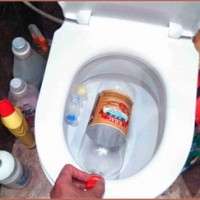 How to clean the toilet with a bottle: step-by-step installation + an overview of alternative methods
How to clean the toilet with a bottle: step-by-step installation + an overview of alternative methods  How much does it cost to connect gas to a private house: the price of organizing gas supply
How much does it cost to connect gas to a private house: the price of organizing gas supply  The best washing machines with dryer: model rating and customer tips
The best washing machines with dryer: model rating and customer tips  What is the color temperature of light and the nuances of choosing the temperature of the lamps to suit your needs
What is the color temperature of light and the nuances of choosing the temperature of the lamps to suit your needs  Replacement of a geyser in an apartment: replacement paperwork + basic norms and requirements
Replacement of a geyser in an apartment: replacement paperwork + basic norms and requirements
Where have you been before? 15 years ago I installed a toilet on a cement mortar. Then there was nothing else. A familiar builder advised to put 5 cm of concrete on top for strength. That's exactly what I did. I laid the tile on top. I'm doing repairs now. I won’t know how to dismantle it easier. Maybe tell me. Now, of course, I will do the right technology.
In this situation, you will have to be patient and act carefully. Around the perimeter of the toilet with a thin drill you need to drill holes in increments of about half a centimeter. This is done in a couple of rows. Then gently knock down the chisel and pull out the toilet.
Last year, an overhaul was carried out in our apartment building. They changed a lot, down to the toilet.All this is good, but the professionalism of the teams that performed the work leaves much to be desired. They work the old fashioned way, and in the courtyard is the 21st century. The toilet was sloppy on cement, which froze unevenly. Now, a year later, I was thinking about a remake. I’ll remove the cement and try to put it on the glue.